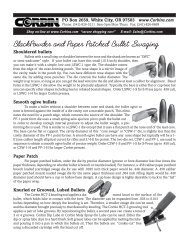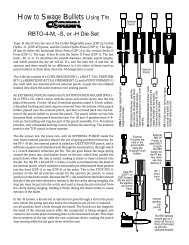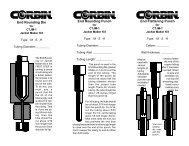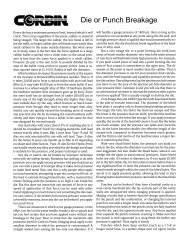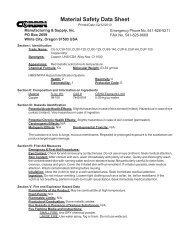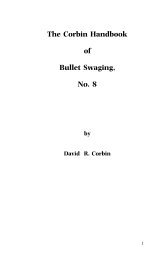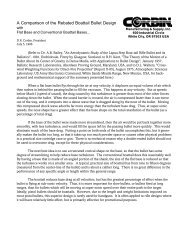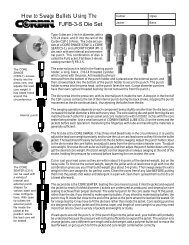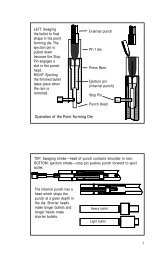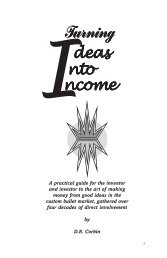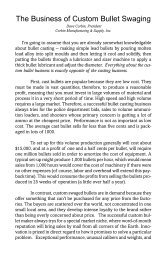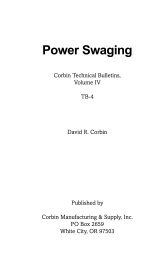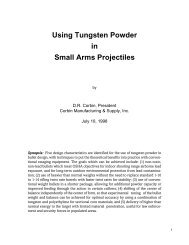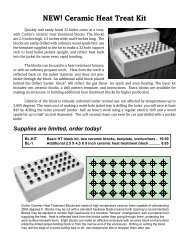HB-9 updated text (PDF) - Corbin Bullet Swaging
HB-9 updated text (PDF) - Corbin Bullet Swaging
HB-9 updated text (PDF) - Corbin Bullet Swaging
You also want an ePaper? Increase the reach of your titles
YUMPU automatically turns print PDFs into web optimized ePapers that Google loves.
tween half and one thousandth, depending on whether it is an Auto-loader<br />
or not—some pistols have a problem with slightly larger bullets which<br />
bulge the case and cause feeding failures).<br />
On the other hand, if I had a bullet that shot well in a given gun, I<br />
couldn’t care less if the bullet was undersized, lopsided and backward!<br />
The goal is to hit where you aim, and if the bullet does that, forget about<br />
what it ought to be and just be happy that it works so well. Some armchair<br />
ballisticians tend to wind themselves up so tightly in their theories<br />
that they miss the fun and the point of it all: shooting. If it works, it must<br />
be right by definition.<br />
Many factory barrels of the same caliber are far different from each<br />
other in diameter. The differences in bore diameter at various points even<br />
in the same barrel can be far more than the wildest tolerances in any<br />
bullet. Since the whole idea of controlling bullet diameter and tolerance<br />
is to make it fit into the bore, or the rifling grooves, there’s a problem<br />
here!<br />
Why worry about an overly precise bullet diameter if the bore isn’t at<br />
least that precise? We’ve had clients send us sample bullets, pushed through<br />
a factory barrel, that came out as much as .41 caliber from a .40 caliber<br />
pistol! In one instance, the client sent the gun back twice and got two<br />
different oversized barrels, both different by as much as 0.005 inches<br />
from each other. I won’t mention the gun-maker, but it is a respected<br />
name and the problem isn’t unique.<br />
This doesn’t mean that it isn’t important to have good control over<br />
bullet diameter. It merely means that you should not take the “published<br />
specifications” for granted. Measure your gun if you really want to specify<br />
the bullet correctly to fit it. If you don’t know how to measure it, you can<br />
fire a low velocity slug through it and capture the slug in water, and send<br />
us the slug to measure. By low velocity, I mean just enough pressure to<br />
get it out of the barrel reliably.<br />
Measuring a barrel is an art. Firing the bullet through it only gives<br />
you an idea of the diameter at the point where the bullet came out. Suppose<br />
your barrel has “waves” in the bore, where it varies 0.002 inches<br />
larger than the average, but the muzzle is actually tight at 0.001 smaller<br />
than the standard specifications. The bullet might expand when it passed<br />
through the big areas, but it would be drawn down again when it hit the<br />
tight spots. Which dimension is really the size of your bore? Who knows—<br />
it all depends on your meaning. Average? Mean? Tightest point? Loosest<br />
point? Standard deviation?<br />
You want a bullet to fit so it won’t be distorted and so powder gas<br />
won’t escape around it and cut the jacket or lead like a torch. It’s worse to<br />
have gas jetting around the bullet in the loose places than it is to have the<br />
37



